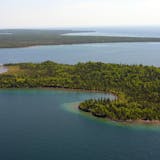We were heartened to see President Obama celebrate the return of the name Denali to Alaska's, and our nation's, tallest mountain, a move that signals both the power of naming and the possibility that change can come, even to famous landmarks.
We are part of a coalition of citizens who would like to see the name Bde Maka Ska returned to Lake Calhoun. A return to the original Dakota name (meaning "White Earth Lake") would honor the area's first inhabitants, signaling Minneapolis' evolution as a community composed of many, with visionary citizens willing to understand history, re-frame and move forward together.
The history of this place, and its naming, are important. Minnesota's original indigenous population, the Dakota, fished, gathered food and camped along the shores of Bde Maka Ska for centuries prior to white settlement. By the 1830s, the Dakota of Mni Sota ("The Land Where the Waters Reflect the Sky") faced starvation due to the overhunting of local game by the fur trade. Though they had always gardened and gathered native plants for food, a community called Heyate Otunwe ("Village to the Side"), led by Mahpiya Wicasta (Cloud Man), was among the first Dakota groups to succeed at large-scale farming. The crops harvested at this site were shared with other Dakota bands, ensuring the survival of the larger community. This story of farming, innovation and generosity holds significance for our state, and is all but forgotten by many.
By 1824, John C. Calhoun, then U.S. Secretary of War, had established the Bureau of Indian Affairs under the control of the War Department, signaling that indigenous peoples were regarded as enemies of westward expansion by white settlers and the U.S. government. Concurrently, Calhoun penned what would become the Indian Removal Act, signed into law in Washington, D.C., in 1830, which opened the door for removal treaties, ushered in policies that promoted tribal ethnic cleansing (such as the Cherokee Trail of Tears), and cleared the path for Euro-American settlement.
Calhoun, a native of South Carolina, was also a staunch proponent of slavery — famously calling it a "positive good" rather than a "necessary evil" while serving in the U.S. Senate in 1838 — and is credited by some historians for a fiery rhetoric that fueled Southern threats of secession prior to the Civil War.
So why is Calhoun's name memorialized with a lake in Minneapolis?
No evidence exists that Calhoun ever visited the area; as Secretary of War, Calhoun authorized funds in 1818 for a string of military forts, including Fort Snelling, to defend the Northwest Territories and help secure the fur trade, prompting surveyors to name the lake in his honor, sometime before 1839.
Recently, the Minneapolis Park and Recreation Board passed a resolution recognizing dual names for this place, Lake Calhoun and Bde Maka Ska. While the formal recognition of the original name by the Park Board is an important gesture, we feel further action is needed to acknowledge the significance of the original name. While the Park Board may not have the authority to officially change the name, those who do will certainly look to the board for guidance and a show of solidarity.



